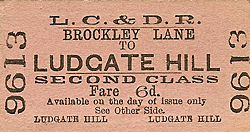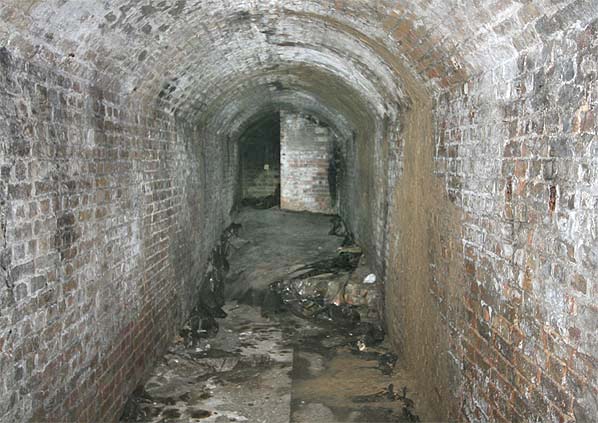| Notes: Brockley Lane Station had a street level entrance on the west side of Brockley Road on the down side of the line. From the entrance a path led to a subway under the line with stairs up to the two platforms. The platforms were largely constructed of wood apart from short sections on the bridge over Brockley Road, which were brick. The track level |
 |
buildings were also of timber construction and stood at the London end of the station. Waiting rooms were provided on both platforms, with an office for the Stationmaster on the down side.
|
The Great Northern Railway opened a coal depot on the up side of the line to the west of the station in December 1883; Martins sidings were located opposite the coal depot.
After closure to passengers, Brockley Lane remained open for freight traffic finally closing on 4th May 1970 by which date only the coal depot was still open. Brockley Lane signalbox was sited on the up side between the station and the coal depot; it closed on 7th March 1973. The stationmaster's house was located in Brockley Road, opposite the station entrance. After closure the entrance building was leased to Boy Scouts. The platforms were largely demolished in 1929, leaving just two short sections of brick platform on the bridge over Brockley Road; these were finally removed after 1982.
|
The street level building was latterly used as a shop selling bric-a-brac and secondhand furniture but it was badly damaged by a fire in the summer of 2004 and subsequently demolished.
BRIEF HISTORY OF THE GREENWICH PARK BRANCH
| The original plans for the Greenwich Park branch proposed a line from Nunhead through Greenwich terminating at the Royal Dockyard in Woolwich. With the opening of the South Eastern Railways extension from Greenwich to Woolwich in 1849 there was no longer a need to serve Woolwich and the London Chatham & Dover Railway were eventually authorised |
 |
to build a 2m18ch line between Nunhead and Crooms Hill, on the western side of Greenwich Park by an Act of Parliament in July 1863.
Financial problems delayed construction until 1871 when the branch opened as far as Blackheath Hill on 18th September with one intermediate station at Lewisham Road; a second at Brockley Lane was opened in June 1872. There was a regular 45 minute service although most trains shuttled between Nunhead and Blackheath Hill which was unpopular with commuters who had to change at Nunhead to reach central London.
 |
Despite disappointing receipts, the LCDR continued with their proposal to extend to Greenwich. The original powers had lapsed and a new Act was required which was received in 1881. The company was still in financial difficulty and the extension wasn’t completed to Greenwich Park (Greenwich until 1900) until 1st October 1888. A substantial terminus was built in Stockwell Street and not Crooms Hill as originally planned because housing development had overtaken the railway. |
The extension failed to attract additional traffic to the line which was unable to compete with SER's direct line from Greenwich into central London. Leisure traffic was more successful however with the branch providing a convenient route to Crystal Palace, a major tourist destination in South London.
| With the amalgamation of the LCDR and SER in 1899, Greenwich was renamed Greenwich Park to avoid confusion and with the introduction of electric trams from 1908 it was soon clear that the line could never make a profit. A push-pull service was introduced in 1913 in an attempt to cut losses and by the start of WW1, a 20 minute peak hour service and |
 |
45 minute off peak service was being maintained. Both the Greenwich Park and Crystal Palace branches were closed on 1st January 1917 as a war time economy measure; the Crystal Palace service was reinstated in 1919 but the Greenwich Park branch never reopened.
After closure, the line remained open for freight traffic as far as Brockley Lane and the section between Brockley Lane and Lewisham Road was used for carriage storage. There was a proposal to electrify the line and reopen it but this was quickly dropped
 |
In 1927 Southern Railway refurbished the section of line between Nunhead and Lewisham Road as part of a scheme to improve freight operations in the locality; this involved building a spur down to join the Mid Kent line between St. Johns and Lewisham, at the same time the track was reballasted and relaid reopening on 7.7. 1929. The remaining severed |
section of the branch between Lewisham Road and Greenwich Park was formerly abandoned by Act of Parliament in 1929.The new loop line number of freight services in the area and it was electrified in 1935.
Passenger trains began using the loop on 30th September 1935, with a peak-hour service between Dartford and St. Paul's (Blackfriars) taking the pressure off the overcrowded services into Cannon Street and Charing Cross. This passenger services was withdrawn on 16th October 1939 as a war time economy measure but was reinstated on 12th August 1946.
 Today the loop line forms an important part of Southeastern rail network with two trains an hour in each direction running between Dartford and Victoria. Since the line reopened in 1929 there has been no suggestion that the two intermediate stations at Brockley Lane and Lewisham Road should be reopened. Today the loop line forms an important part of Southeastern rail network with two trains an hour in each direction running between Dartford and Victoria. Since the line reopened in 1929 there has been no suggestion that the two intermediate stations at Brockley Lane and Lewisham Road should be reopened.
Sources: London Railway Record Vols. 7, 8 & 11(April & July 1996 & April 1997) published by Connor & Butler
Other web sites: Abandoned Tube Stations . Tickets from Michael Stewart & Brian Halford Luggage label from Gavin Mickey Felvus
To see other stations on the Greenwich Park branch click on the station name: Greenwich Park, Blackheath Hill, Lewisham Road & Nunhead
|

old1.jpg)

5.jpg)
1.jpg)

 Home Page
Home Page 





 Today the loop line forms an important part of Southeastern rail network with two trains an hour in each direction running between Dartford and Victoria. Since the line reopened in 1929 there has been no suggestion that the two intermediate stations at Brockley Lane and Lewisham Road should be reopened.
Today the loop line forms an important part of Southeastern rail network with two trains an hour in each direction running between Dartford and Victoria. Since the line reopened in 1929 there has been no suggestion that the two intermediate stations at Brockley Lane and Lewisham Road should be reopened.